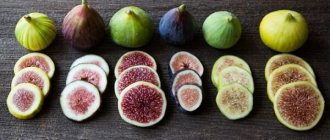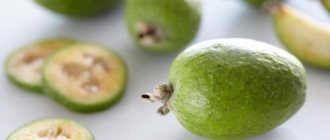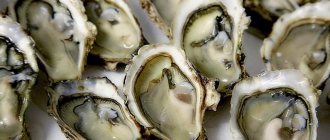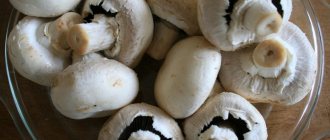Nowadays it is rare to surprise anyone with exotic fruits. You don’t have to go to Asian and Eastern countries to get them. Most fruits are available on supermarket shelves. The “overseas guest” passion fruit raises many questions. The aroma and taste of the fruit are liked the first time; both children and adults eat it with pleasure. The slightly elongated, round fruit immediately attracts attention. If most of those who travel to exotic countries are familiar with passion fruit, it often causes confusion among new buyers. And the first question that comes to mind: “passion fruit - how to eat?”
Passion fruit is widely used in cooking in Asian countries and as a dessert. It has a rich composition of nutrients, suitable for fitness diets, light snacks, and varied menus. Dishes with the addition of healthy fruit become piquant and have aromatic notes. What are the benefits and harms of passion fruit? Are there any peculiarities of use? Let's find out the details.
What does passion fruit look like?
The plant is cultivated in Asia, South America, and Australia. In our country, the fruit is known by different names - Granadilla purpurea, Passion flower, Passion flower. In appearance, the fruit can be compared to large plums with a dark purple or yellowish color. They grow from 5 to 14 centimeters in length. Weight -30-60 grams. Fully ripe passion fruit attracts attention with its wrinkled skin, while unripe ones have a smooth surface. The skin is quite elastic, reliably protecting the fruit pulp from damage.
How does passion fruit grow?
The homeland of passion fruit is Brazil. Later, fruit trees began to be cultivated in other countries. There are two types of vine plant. They differ in color - yellow and violet (purple) passion fruit. A woody perennial tree with long branches and a shallow root system. The leaves are large, approximately 22 centimeters long, and have toothed edges. The antennae may be purple or yellow, depending on the type of fruit. The flowers are very beautiful, formed in the axils of a young vine, and consist of five sepals. They are distinguished by bright, rich shades.
Since the plant is subtropical, it grows well at an altitude of 700 to 1200 meters above sea level. Passion fruit is sensitive to temperature changes. Depending on the conditions, ripening periods differ. So, in India, it can ripen all year round.
Passion fruit season in Thailand
Traveling to exotic countries, tourists enjoy not only beach holidays, excursions, but also local delicacies. Many people are interested in the ripening season of tropical fruits. Fragrant passion fruit attracts increased interest with its fantastic taste.
The passion fruit ripening season in Thailand lasts from December to April. During this period, you can taste the healthy fruit and appreciate the benefits.
How to peel passion fruit?
The fruit does not need to be cleaned in any special way. To eat it or use it for cooking, you need to make a longitudinal cut and scoop out the jelly-like pulp with a spoon. It makes up approximately 50% of the fetus.
The rest is inedible peel. Although in some countries they manage to make jam from it by grinding the whole fruit along with pulp and sugar, then bringing it to a boil over low heat. But passion fruit seeds are edible and pleasant to the taste, but in large quantities they have a hypnotic effect. Therefore, sometimes the jelly pulp is separated from them: they use a mixer at the lowest speed, and then pass everything through a sieve.
We recommend: How to bleach yellowed plastic correctly and safely?
How to eat passion fruit
An inexperienced tourist does not know how to properly consume an unusual fruit. It's actually simple.
- Passion fruit is thoroughly washed under running water.
- Cut into halves.
- The pulp is scooped out with a spoon (until the white layer on the peel).
You can swallow the useful mass without chewing, along with small bones. Passion fruit peels are quite bitter, so it is recommended to discard them.
How to choose passion fruit
Yellow or green fruits are less sweet. Used for making juices. However, you can safely buy unripe, green passion fruits. The fruits ripen at room temperature.
The second sign of benefit and quality is weight. In terms of size it should be large. This is a sign of both good taste and juiciness. If the weight is insufficient, it means that the passion fruit pulp has dried out.
It's difficult to judge quality based on aroma. Since the thick skin of the fruit does not allow odors to pass through.
Can you eat passion fruit seeds?
The seeds are edible. However, when chewing them, a slight bitterness is felt. If you don't want to swallow, rub the pulp through a sieve. It is difficult to remove the seeds, so this procedure will make the process easier.
What is made from passion fruit?
Dried passion fruit has a sweet taste. This is an alternative to sugar. A natural sweetener gives an amazing taste to drinks, cocktails, cakes, pastries, creams, sweet sauces, fruit salads, and ice cream. The aromatic fruit goes well with baked goods and is suitable for making pie fillings.
What does passion fruit go with? If you add a little fruit to meat or fish dishes, they will acquire unique piquant notes. In various countries, the fruits are used to prepare numerous dishes - from healthy yoghurts, salads, juices, pancakes to ice cream and fluffy desserts. A good combination is obtained with lemon juice and hot pepper.
How to eat passion fruit correctly
The aroma of the fruit is divine. It immediately evokes appetite and a desire to taste the pulp. The jelly-like substance smells sweet, but the taste of the pulp is tart and sour.
Although it is precisely due to its sourness that the fruit removes thirst in the heat and is considered the best natural remedy in the world for toning the body.
It is easy to consume fresh. You need to cut it in half and carefully scoop out the pulp with a spoon. Many people sprinkle passion fruit with sugar to improve the taste.
Fact!
In Thailand, the pulp is sprinkled with salt and a little pepper, and in the Philippines it is eaten only with chili pepper.
You can eat fruit seeds that go on sale in our country without hesitation. They are small and will not cause any harm to the body. On the contrary, they contain the main amount of vitamin C. But if the fruits were brought from abroad and the seeds are large, it is better not to swallow them. They can cause intestinal upset and colic.
The peel is not used for food, it just needs to be thrown away. And the white layer, which is located between it and the pulp, is also better not to eat. It's not harmful, just very bitter.
Passion fruit flavor
It is quite difficult to describe the taste of passion fruit; it is individual and does not resemble any specific fruit. Rather, it resembles a mixture of several fruits and berries at the same time. Ripe passion fruit is sweet, with a slight sourness, and can be slightly tart. For some people it is a mix of peach, gooseberry and sea buckthorn, while others feel a mixture of kiwi strawberry and apricot in “one bottle”. In any case, the aroma and taste of the unusual exotic will not leave indifferent the person who tastes the juicy passion fruit for the first time.
Interesting combinations of passion fruit with other products
Gourmets can try experimenting with passion fruit:
- The easiest way to diversify the taste of the pulp is to grind it with honey . This is exactly what they do in Vietnam, where passion fruit is popular among locals and tourists;
- If you want something more original, then you can follow the example of the Mexicans. They mix the pulp of the fruit with red pepper and drop a little lemon juice into it. Salt will also work instead of lemon;
- Passion fruit will perfectly complement the taste of any fruit salad . It is best if it contains more soft fruits like kiwi and peaches;
- Tea lovers will also be able to diversify their diet. To do this, passion fruit is dried and then its pieces are brewed with any tea . The drink will become more aromatic, and its benefits will increase significantly. In addition, residents of the tropics know that passion fruit perfectly quenches thirst and slightly tones.
How to store passion fruit
To transport passion fruit safely, it is recommended to wrap it tightly in paper or place it in a small basket.
Unripe fruits will ripen at room temperature in two days. Ripe ones must be placed in the refrigerator. Shelf life – 7 days.
Freezing is useful for long-term storage of fruits. To do this, passion fruit pulp is mixed with sugar. Place in plastic bags and freeze. Passion fruit can be stored this way for 12 months. At the same time, the beneficial properties of the fruit are preserved.
Selection rules
To choose the most healthy fruit in a store or fruit market, follow a few simple rules:
- pay attention to the peel. A healthy passion fruit should be firm and slightly rough. The presence of spots and cracks indicates that the fruit will soon deteriorate;
- take the fruit in your hand and try to estimate the weight. Fruit that is too light is a sign of emptiness: perhaps the pulp has already dried out;
- shake the fruit: you should hear a characteristic sound indicating the presence of pulp with juice;
- If you want to choose sweeter fruits, then choose purple passion fruit. It is sweeter than the yellow variety.
Most of the fruits lying on the shelves are not yet ripe. There’s nothing wrong with that, just when you get home, put the fruit in a vase at home or put it in a paper bag. In a couple of days, the pulp will arrive and you can enjoy its taste. Store ripe fruits in the refrigerator or any cool place at a temperature of no more than +1 degrees. The maximum shelf life is 5-7 days.
If you want to extend the shelf life, freeze the fruit pulp with sugar. It will be stored for up to 1 year.
Composition and calorie content
Exotic fruits are a real storehouse of vitamins, macro and microelements:
- carotenes;
- manganese;
- vitamins A, C, E, H, K, group B;
- ash;
- sodium;
- dietary fiber;
- amino acids;
- magnesium;
- polyunsaturated fatty acids;
- potassium;
- chromium;
- iron;
- aluminum;
- organic acids;
- phosphorus;
- iodine;
- antioxidants;
- iron;
- ascorbic acid;
- flavonoids;
- sulfur;
- copper;
- fructose;
- folic acid;
- fluorine;
- calcium;
- pectin.
Passion fruit is especially high in potassium and iron. Calorie content of 100 g of product is 70 kcal.
Vitamins
Thanks to its vitamin composition, the healthy fruit improves immunity and protects the body during the season of colds and infectious diseases.
Folic acid is beneficial during pregnancy. B vitamins help fight stress.
Minerals
Potassium is an important trace element for the cardiovascular system. Passion fruit is a source of iron, an essential element for hematopoiesis and hemoglobin formation.
The fruit is supplemented with other minerals, the exotic fruit becomes indispensable and useful in dietary and healthy eating.
Where to buy and how to choose
Passion fruit can be found in supermarkets in large cities and in specialty tropical fruit stores. The purple varieties are most often found on sale.
Fully ripe fruit should be:
- Large and heavy for their size - this means that there is a lot of moisture inside and the pulp is juicy.
- With thick wrinkled skin. This applies to both the common purple species and the yellow one. A smooth skin indicates that the passion fruit is not yet ripe.
- The yellow variety will be deeply golden, while the purple variety will be almost black.
This passion fruit is more tasty, aromatic and sweet.
Avoid overripe fruits. Minor cracks and spots on the passion fruit peel are normal. Minor abrasions on the surface usually do not affect the quality of the passion fruit. Avoid fruits with skin that is too dry, wrinkled, or severely damaged.
Unripe passion fruit tastes very tart. To ripen at home, leave it at room temperature away from direct sunlight.
What are the benefits of passion fruit?
When processed, the fruit does not lose its beneficial properties; dried fruits are just as healthy as fresh fruits. The effect of a fruit rich in vitamin-mineral complex is diverse.
- Improves memory. Stimulates the body during increased mental or physical stress.
- Natural aphrodisiac.
- Prevents the development of vitamin deficiency.
- Useful for low immunity.
- It has antiviral, diuretic, immunostimulating, regenerating, anti-inflammatory effects.
- Prevents the development of hypertension and atherosclerosis.
- Lowers blood cholesterol levels.
- Lowers blood sugar
- Normalizes the activity of the gastrointestinal tract. Strengthens intestinal motility, removes toxins from the body.
- Strengthens the walls of blood vessels.
- Normalizes metabolic, digestive, water-lipid, alkaline metabolism.
- Increases resistance to infectious diseases.
- Removes excess fluid from the body.
- Preventive drug for cancer.
- Passion fruit is good for visual acuity.
- Cleanses the blood.
- Quickly regenerates cells.
- Strengthens the cardiovascular system.
It is enough to eat 50 g of fruit a day to fill the body with many useful substances. Experts recommend including the fruit in your diet daily.
In Asian countries, they have long known about the benefits of passion fruit for the female body. “Fruit of Passion” has rejuvenating properties.
The introduction of fruit into a regular diet helps:
- stabilization of the central nervous system;
- normalization of the menstrual cycle;
- strengthening nails and hair;
- eliminating symptoms during menopause;
- improved sleep;
- preventing the development of cancer of the uterus, ovaries, mammary glands and osteoporosis;
- eliminating swelling during pregnancy;
- prevention against colds and infectious diseases;
- improving mood and digestion.
For men, passion fruit is no less useful. Regular consumption of fruit contributes to:
- improvement of potency, quantitative composition of sperm;
- preventing the development of colon and prostate cancer;
- stabilization of the central nervous system;
- improving memory, concentration;
- increasing endurance;
- improvement of digestive and metabolic processes;
- strengthening the heart;
- activation of the production of male sex hormones;
- increasing immune strength.
The benefits and harms of fruit
The pulp of the fruit contains vitamins, microelements, antioxidants, proteins and fats, and fiber. When eating passion fruit, you will notice that:
- blood pressure normalizes;
- bowel function improves;
- sleep becomes stronger;
- memory improves.
Regular inclusion of passion fruit in the diet reduces the risk of cancer.
There is practically no harm from the fruit if you do not overeat them. Large quantities of fruit eaten can cause diarrhea. Doctors do not recommend eating passion fruit for people who have high stomach acidity.
Areas of use
Passion fruit has found wide use in various fields.
In cosmetology
Masks and lotions and scrubs are prepared based on the fruits. The products are suitable for delicate skin. Protect from ultraviolet rays. They have a rejuvenating effect. Get rid of acne.
Passion fruit oil is especially popular when added to the production of face and body care products. The component has regenerating, restorative, moisturizing properties. In its pure form, it is an excellent massage product.
Dietetics
Since passion fruit is low in calories, it is suitable for dietary nutrition. The body receives all the beneficial substances. And you don’t have to worry about your figure.
Cooking
The most common use of passion fruit is making healthy juices, cocktails, and drinks. The fruit will complement the taste of baked goods, seafood, desserts, fish, liqueur, rum, and chocolate.
Benefits of passion fruit
Exotic fruits contain organic acids, vitamins and minerals, they have no cholesterol, and contain healthy fiber. Passion fruit is considered an excellent antioxidant that can boost immunity, slow down the aging process and reduce the risk of developing cardiovascular diseases. The presence of fiber in fruits helps improve digestion and cleanse the intestines.
The fruit contains beta-carotene and vitamin A, which support vision, skin elasticity, and good condition of hair and nails. The sedative effect of passion fruit has a positive effect on the nervous system, relieves stress and gives sweet sleep. Passionflower has a beneficial effect on the liver and genitourinary system, helps the female body during menopause, stabilizes blood pressure, relieves migraine attacks and helps fight excess weight.
In medicine, the above-ground part of the plant is used - leaves, buds and flowers, stems, tendrils and unripe fruits. Since time immemorial, it has been used as a sedative for bone fractures and bruises, relief from pain, burns and inflammation. Passionflower relieves minor cramps and nervous conditions, has antispasmodic, antifungal and antiseptic effects, and slightly reduces the craving for alcohol and nicotine. The pharmacological industry produces tinctures, extracts, preparations and ointments.
Cocktail with passion fruit Photo: © RitaE (Pixabay Free License)
Cosmetics based on passion fruit oils and juice tone and moisturize the skin, tighten pores, help get rid of acne and protect against ultraviolet radiation, while shampoos and conditioners strengthen hair roots and prevent fragility. The benefits of this exotic fruit have been proven, and all we can do is take advantage of the recommendations of nutritionists, doctors and cosmetologists.
Properties
Passion fruit is of great value to the human body due to the presence of a lot of useful substances. The list is huge, so this is only the most important.
- The calorie content of passion fruit is about 70 kcal per 100 g of fresh fruit.
- Carbohydrate content - up to 21%, protein - 2.5%, fiber - 11%.
- Fruit juiciness is up to 40%.
- Vitamin content: A - 7.5%, B2 - 11%, B3 - 10%, B6 - 8%, B9 - 3%, C - about 36%.
- Iron content - 12%, phosphorus - 10%, copper - 9.5%, magnesium and potassium - 7% each, calcium and zinc - 1%.
Passion fruit season calendar
| Jan | Feb | March | Apr | May | June | July | Aug | Sep | Oct | But I | Dec | |
| South Africa | ✔ | ✔ | ✔ | ✔ | ✔ | ✔ | ✔ | — | — | — | ✔ | ✔ |
| Colombia | ✔ | ✔ | ✔ | ✔ | ✔ | ✔ | ✔ | ✔ | ✔ | ✔ | ✔ | ✔ |
| Vietnam | ✔ | ✔ | ✔ | ✔ | ✔ | ✔ | ✔ | ✔ | ✔ | ✔ | ✔ | ✔ |
| Zimbabwe | ✔ | ✔ | ✔ | ✔ | ✔ | ✔ | ✔ | — | — | — | ✔ | ✔ |
| Kenya | ✔ | ✔ | ✔ | ✔ | ✔ | ✔ | ✔ | ✔ | ✔ | ✔ | ✔ | ✔ |
| Thailand | ✔ | ✔ | ✔ | ✔ | — | — | — | — | — | — | — | — |
SAVE USEFUL INFORMATION ON YOUR FAVORITE SOCIAL NETWORK PAGE:
Cooking recipes
The healthy fruit can not only be eaten in its pure form, but also used to prepare interesting drinks, cocktails and desserts. There are different recipes with passion fruit that you can make at home:
- delicious juice;
- cocktail with or without alcohol content;
- jam or preserves;
- liquor;
- homemade yogurt;
- ice cream;
- other desserts.
The recipe for passion fruit jam is as follows:
- From 10 fruits cut with a knife, all the pulp is taken out, placed in a deep plate and sent to the refrigerator.
- The peel is placed in a pan, filled with water, placed on the stove and cooked for 30 minutes.
- With the help of a spoon, the inside of the peel is cleaned, combined with half a glass of the liquid in which it was cooked, and crushed with a blender to a puree.
- The resulting mass is combined with sugar (100 g or to taste), lemon juice and brought to a boil. After 3 minutes, the puree can be removed from the heat.
- Passion fruit pulp from the refrigerator is added to the hot mixture. The jam is transferred to a clean glass jar and then stored in the refrigerator.
Even an inexperienced housewife can make jam according to this recipe. And its taste will delight all household members for a long time.
Why is the fruit called passion fruit?
The name comes from mara kuya (can mean "food in a bowl") in the Tupi Indian language. The Tupi language was widely spoken in Brazil, but is now considered a dead language. The Tupi language did not have a written language and was essentially a collection of dialects, so it is difficult to say unequivocally what the name of the fruit originally sounded like: passion fruit or maracuja, or maracuja.
In English-speaking countries, passion fruit is called passion fruit, which is more associated with the flowers of these plants than with the fruit itself. In the 16th century, a strange flower that came to Europe became a visual religious symbol of the passion of Christ and the crucifixion itself. For which it received the scientific name Passiflora or Passion flower (“passion flower”).
What does passion fruit taste like?
If you look at a photo of the fruit, it’s immediately clear that the edible part is in the middle. The peel of the fruit is not edible. The same can’t be said about the pulp, it’s juicy and literally melts in your mouth, it has a large number of small seeds and its taste reminds some of kiwi mixed with sea buckthorn, and for others it tastes like kiwi mixed with strawberries.
Passion fruit is best eaten raw, but it is also possible to prepare desserts and juices. And the seeds of the fruit are very useful.
What kind of fruit and what does passion fruit taste like?
Passion fruit (“edible passion flower”, “passion fruit”, “purple passionflower”, “purple granadilla”) is a heat-loving tropical plant of the genus Passionflower, the fruits of which are violet, yellow, purple in color and round or square in shape. The size of one passion fruit fruit ranges from 5-7 cm to 12-14 cm, and weight - from 30-35 g to 45-55 g. Ripe fruits have a smooth skin, while overripe ones have cracked and rough skin.
Passion fruit pulp is jelly-like, very sweet and aromatic. It is used to make syrups, sweet sauces, desserts, and juice. The latter can be drunk as a stand-alone drink or added to other juices to make them more tasty and aromatic. Although the homeland of the exotic fruit is Brazil, today it is also cultivated in Australia, many other countries in South America and South Africa with a tropical or subtropical climate.
Passion fruit has a pleasant sweet and sour, but slightly tart taste. For some people, the taste of passion fruit resembles the taste of kiwi, for others - the taste of overripe sea buckthorn, for others - a mixture of tastes and aromas of gooseberries, apricots, strawberries, plums and peach. To find out what passion fruit really tastes like, you should simply purchase a ripe fruit with a rough and wrinkled skin. We guarantee that the taste of this exotic fruit will not leave you indifferent!
Passion fruit: beneficial properties and contraindications
Useful properties 1. Passion fruit is a healthy food product. Because it's low in calories, it's a great snack option. Along with vitamins A and C, when consuming tasty fruits, the body receives niacin, riboflavin and other B vitamins. Edible seeds contain unsaturated fatty acids.
The exotic fruit is a source of vital iron and potassium for the body, as well as large amounts of phosphorus and calcium, which together ensure the strength of bones and teeth.
2. The seeds of Passiflora edulis produce an oil that is found, for example, in cosmetic products such as sunscreens and massage mixtures. The main ingredients of the product are acids: linoleic, oleic, palmitic.
3. In South America, the leaves of the edible passionflower have long been used for inflammation, as a diuretic and a sedative for asthma. A Spanish physician named Monardes discovered the plant in Europe in 1569.
4. Flavonoids present in flower preparations cause a sedative-hypnotic effect. Scientists have also discovered them in passionflower leaves.
5. The plant substance lutein not only gives passion fruit its characteristic color, but is also beneficial for vision.
Dangerous properties Since edible passion flowers contain an enzyme that inhibits the activity of monoamine oxidase, they are harmful to health in large quantities, especially in combination with certain foods.
Where is it used?
As mentioned above, due to the high content of vitamins and minerals, the fruit is actually unique and multifunctional. This allows it to be used in a fairly extensive list of areas. For example, in cosmetology, special anti-aging masks, scrubs and other cosmetics have been made based on passion fruit for quite some time. Which, in addition to their main function of smoothing skin and wrinkles, also protect the skin from sunlight and ultraviolet rays, which is very important in hot countries. They are especially popular, oddly enough, in countries with a rather cold climate. This choice of product is due to the fact that products containing passion fruit juice are the most effective and are more suitable for virtually any skin type.
For people suffering from excess weight, this fruit will be an excellent option for replacing high-calorie desserts with a low-calorie fruit containing a huge amount of useful elements. In addition, it has the property of activating many processes of the human body, which can ultimately lead to accelerated weight loss, which is very good. To achieve optimal results, it is recommended to eat this fruit daily, approximately 50 grams of fruit pulp per day. This will allow you to saturate the body with the entire list of necessary elements.
And, of course, the fruit is used in the preparation of cakes, pies, ice cream, various juices, cocktails and other drinks. It gives a special, sweet-sour, tart taste that is virtually impossible to replicate.










